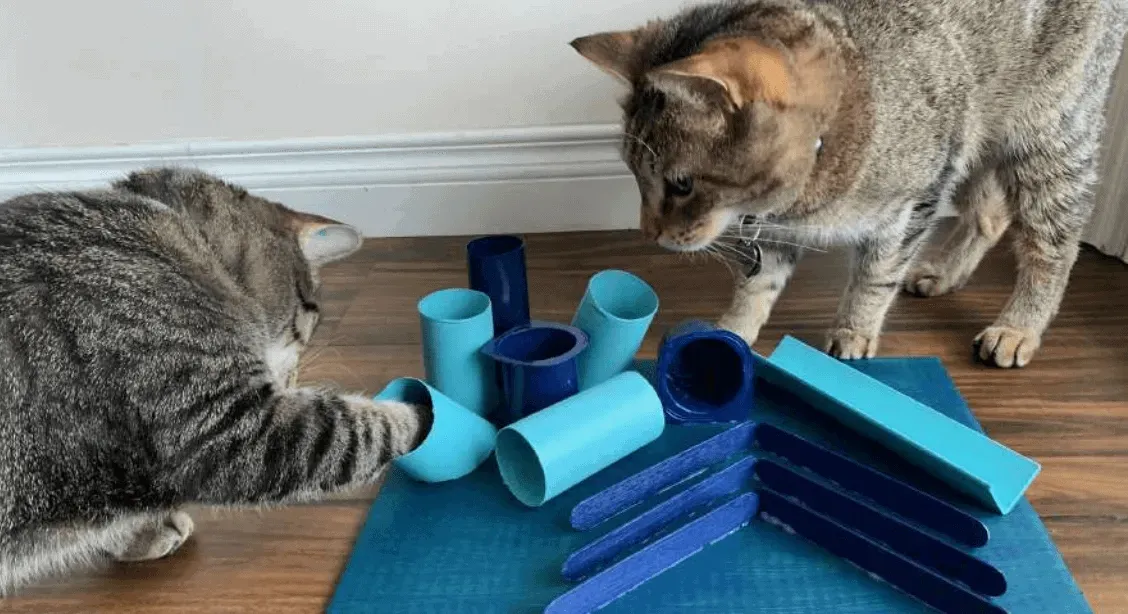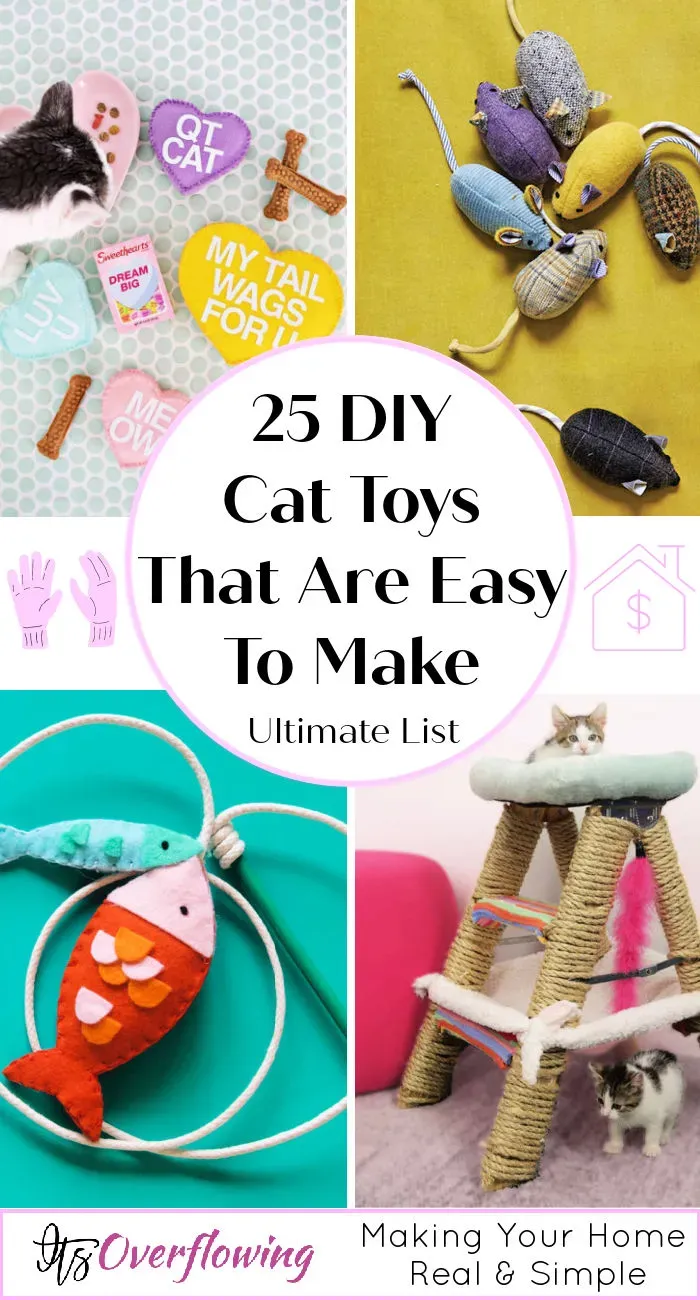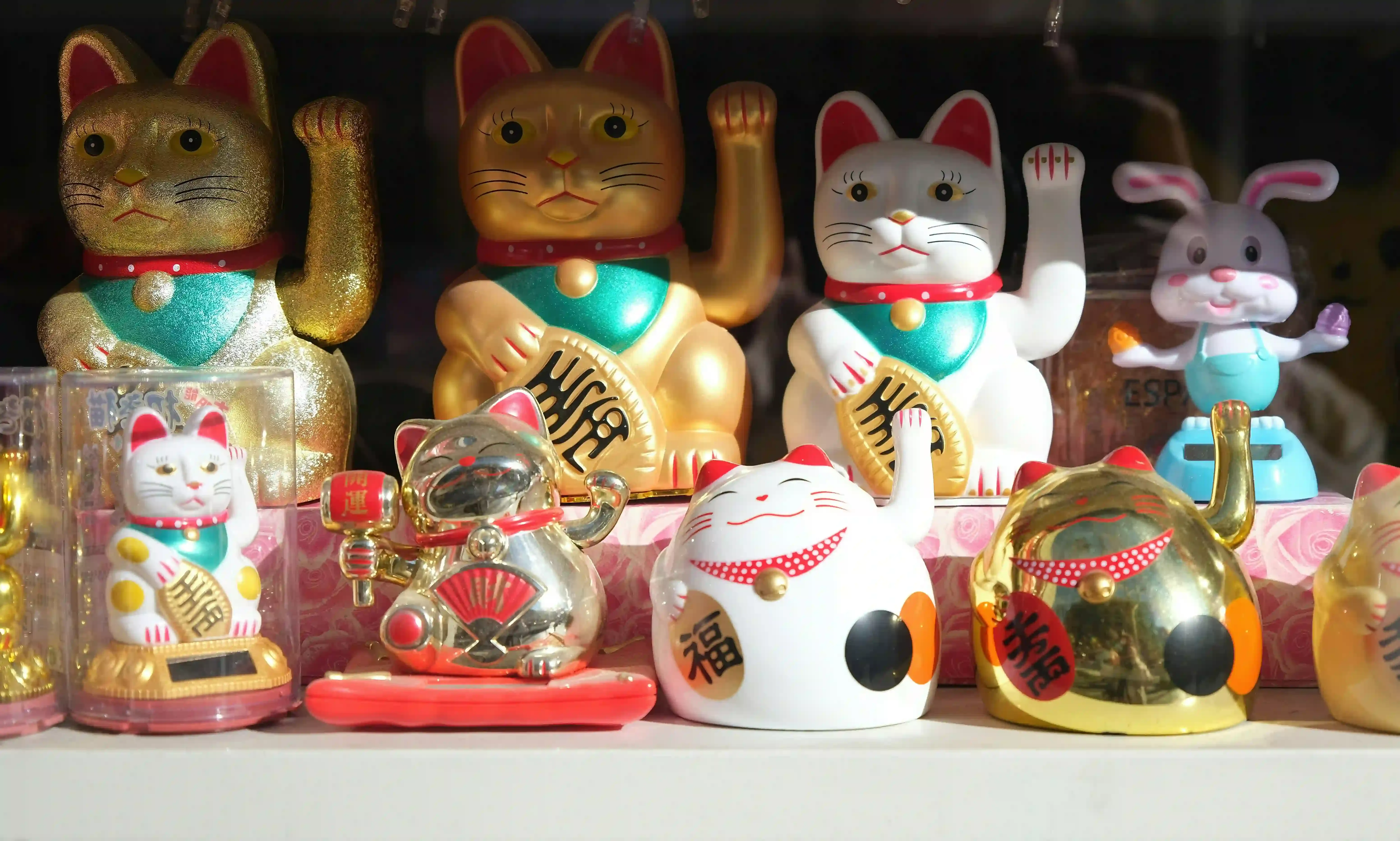Table of Contents
Does your feline friend look at that expensive, store-bought toy for approximately three seconds before batting a dust bunny around instead? Yeah, mine too. Cats are notoriously finicky, and keeping them entertained can feel like a second job. But here's the good news: you don't need a fortune to keep their hunting instincts sharp and their little brains busy. In fact, some of the best tools are probably sitting in your recycling bin right now.
Why Your Cat Needs Playtime (More Than You Think)

Why Your Cat Needs Playtime (More Than You Think)
More Than Just Chasing String
Think playtime is just a cute way to watch your cat bounce off the walls for a bit? Think again. For a cat, batting at a toy isn't just goofing off; it's a deep-seated instinct kicking in. They are, at their core, hunters. That little fluffy predator in your living room needs to stalk, pounce, and 'kill' something, even if that something is just a feathered wand toy. This activity isn't just about burning calories, though that's important too, especially for indoor cats who don't patrol a massive territory. It's vital for muscle tone, joint health, and keeping them agile. Skipping this means you're essentially telling a tiny tiger to lounge around all day, which rarely ends well for either of you.
Keeping Their Brains Busy
A bored cat is often a destructive cat. If they aren't using their energy and intelligence constructively through play, they'll find other outlets. Your furniture, your curtains, maybe even your ankles become fair game. Regular play sessions provide essential mental stimulation, mimicking the challenge of the hunt. This helps reduce stress and anxiety, preventing behavioral problems that stem from frustration or lack of engagement. Watching them figure out how to get a toy out from under the sofa or strategize their pounce is fascinating, and it's proof their brains are getting a workout right alongside their bodies.
- Physical exercise
- Mental stimulation
- Satisfies hunting instinct
- Reduces stress and anxiety
- Prevents behavioral issues
- Strengthens bond with owner
Simple Homemade Cat Toys DIY: Ideas Your Cat Will Love

Simple Homemade Cat Toys DIY: Ideas Your Cat Will Love
The Cardboard Tube Chronicles
let's be real. You just finished a roll of paper towels or toilet paper. Don't toss that tube! It's pure gold in the world of simple homemade cat toys DIY. Cats love batting things around, and a cardboard tube is just the right size and weight for a good whack. You can leave it plain, or get fancy. Cut some slits in the ends and fold them in to create little 'treat traps' – drop a few kibbles inside, and watch them work to get them out. Or, if you're feeling particularly ambitious, cut several rings from a tube and link them together with a bit of string to make a wriggly worm toy. It's ridiculously simple, costs nothing, and taps directly into their inner engineer.
Fabric Scraps and Sock Monsters
Got old t-shirts, socks with no mates, or random fabric scraps lying around? Perfect. These are prime materials for crafting engaging homemade cat toys DIY. A simple knot in an old sock turns it into a chewy, tossable toy. Stuff it with some fabric scraps or even a bit of crinkled paper for extra texture. Or, cut strips from a t-shirt and braid them together to make a sturdy pull toy. My cat, Mittens, has an irrational affection for a 'mouse' I made from a scrap of fuzzy blanket stuffed with cotton balls and tied off with string. It looks like something a kindergartener made, but she carries it everywhere. Just make sure everything is securely fastened and there are no loose threads or small pieces they could swallow.
- Cardboard tubes: Cut, fold, or link for treat dispensers or wriggle toys.
- Old socks: Knot or stuff for chew/toss toys.
- Fabric scraps: Braid into pull toys or stuff into shapes.
- Paper bags (handles removed!): Instant hiding spot and crinkle fun.
- Wine corks: Simple batting fun (supervise!).
- Empty plastic bottles (lids off!): Add kibble for a noisy roller.
The Allure of the Crinkle and Rustle
Cats are sonic connoisseurs. They adore sounds that mimic prey rustling through leaves or grass. Think about how quickly they appear when you open a bag of chips. You can replicate this with your simple homemade cat toys DIY. Crinkle paper (like from packaging) stuffed inside a sock or fabric pouch is a guaranteed hit. Even just leaving a paper bag on the floor (cut the handles off first to prevent strangulation) provides endless entertainment as they dive in and out, making that satisfying crinkle sound. A balled-up piece of parchment paper or even just a dry leaf from outside (check it for bugs first!) can provide minutes of batting, chasing, and auditory delight.
What Makes a Cat Toy "Good" (And What to Avoid)

What Makes a Cat Toy "Good" (And What to Avoid)
Mimicking the Hunt
so you've got your cardboard tubes and fabric scraps ready for some homemade cat toys DIY action. But before you start crafting, let's talk about what actually makes a toy a hit with your cat. It boils down to their inner predator. Good toys mimic prey. They might be small enough to bat around, have unpredictable movements, or make enticing sounds like crinkling or rustling. Think about a mouse or a bird – they move erratically, they hide, they make noise. Your toy should offer some version of this. Texture matters too; some cats prefer soft and fluffy, others like hard surfaces to chew or bat. Size is key; it shouldn't be so small they swallow it easily, but not so large they can't interact with it.
Does your cat ignore that fancy electronic mouse but go nuts for a crumpled piece of paper? That's the unpredictability at work. The best homemade cat toys diy often succeed because they aren't perfect or predictable. They wobble, they don't always roll straight, they might hide under something unexpectedly. This keeps your cat engaged, guessing, and feeling that thrilling spark of the hunt.
- Mimics prey behavior (movement, sound)
- Unpredictable action
- Appropriate size for batting/carrying
- Interesting texture
- Durable enough for play
Safety First, Always
Now, the flip side: what should you absolutely avoid, especially when making homemade cat toys diy? This is crucial. Loose strings, ribbons, yarn, and elastic bands are major hazards. Cats can easily ingest these, leading to potentially fatal intestinal blockages. Same goes for small bells, plastic eyes, beads, or any tiny parts that can break off and be swallowed. Think about the durability – if your cat is a vigorous chewer, a toy that shreds easily into small pieces is a no-go.
Avoid anything with sharp edges, staples, glue that isn't pet-safe, or toxic materials. Plastic bags, while offering tempting crinkle, pose a suffocation risk if a cat gets their head stuck. Tinfoil might seem like fun, but it can have sharp edges when crumpled and isn't safe if ingested. When in doubt, err on the side of caution. Supervise your cat with new homemade cat toys, especially those you've made yourself, to ensure they play safely and aren't trying to eat the toy itself.
Safe Materials/Features | Unsafe Materials/Features |
|---|---|
Sturdy fabric (cotton, fleece) | Loose strings, yarn, ribbons |
Cardboard tubes | Small beads, buttons, plastic eyes |
Crinkle paper (securely enclosed) | Elastic bands, hair ties |
Securely attached feathers | Plastic bags (suffocation risk) |
Pet-safe glue/adhesives | Sharp edges, staples |
Keeping Play Safe and Fun for Your Feline

Keeping Play Safe and Fun for Your Feline
Always Keep an Eye On Things
Making those awesome homemade cat toys diy is only half the battle; the other half is making sure playtime doesn't end with a trip to the emergency vet. This means supervision is non-negotiable, especially with new toys or if your cat is an enthusiastic destroyer. You wouldn't give a toddler a toy with tiny parts and walk away, right? Same principle applies here. Watch how they interact with the toy. Are they trying to eat pieces? Are they getting tangled in string? If a toy starts to fall apart, or if they're fixated on ingesting a component, it's time to put that toy away or modify it. A few minutes of active supervision can prevent a lot of heartache and expensive medical bills. My cat once tried to eat a piece of felt off a toy I made; a quick scoop and replacement with a more durable fabric solved the problem before it became a crisis.
Inspect, Rotate, and Refresh
Just like human toys, cat toys get worn out. Stuffing comes loose, seams split, and once-sturdy materials become hazards. Get into the habit of doing a quick safety check on your homemade cat toys diy before each play session. Look for loose strings, torn fabric, or any small parts that could detach. If a toy is damaged, fix it or toss it. Don't leave broken toys lying around. Also, cats get bored. Leaving the same five toys out all the time is a recipe for feline indifference. Rotate their toys regularly. Keep a stash of toys put away and bring out a few different ones every week. This keeps things fresh and exciting, making those familiar homemade creations feel new again. It's a simple trick, but it works wonders for maintaining their interest.
- Check toys for damage before use.
- Remove or repair broken toys immediately.
- Rotate toys weekly to maintain interest.
- Keep a selection of toys stored away.
- Observe how your cat interacts with the toy.
Cleanliness and Tailoring Play
Your cat's toys spend a lot of time on the floor, getting batted under furniture, and potentially getting slobbered on. They collect dust, dirt, and bacteria. Regularly cleaning your homemade cat toys diy is important for your cat's health. Most fabric toys can go in the washing machine (use a pet-safe detergent and air dry). Cardboard toys can't be washed, so inspect them for dirt or damage and replace them when needed. Beyond cleaning, remember that every cat is an individual. Some love chasing, some love pouncing, some prefer puzzle toys. Pay attention to what your cat enjoys and tailor your homemade creations and play sessions to their preferences. A shy cat might prefer a gentle wand toy session, while a high-energy hunter needs something they can really chase and capture. Adapting to their style makes playtime more effective and enjoyable for both of you.
Playtime Pays Off
So there you have it. Keeping your cat engaged doesn't require a trip to the pet store and a dent in your bank account. A few minutes and some household odds and ends are often all it takes to create something that will pique your cat's interest far more than that expensive laser pointer they ignore. Remember, regular play isn't just about entertainment; it's about keeping your cat mentally stimulated and physically active, which can head off a lot of behavioral issues down the road. Dive into the world of homemade cat toys DIY, keep an eye on safety, and enjoy watching your cat channel their inner predator with your crafty creations.